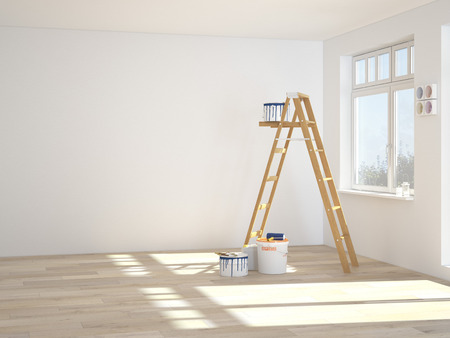1. Gather the Necessary Tools and Materials
Before you start removing old wallpaper and prepping your walls for a fresh coat of paint, its important to gather all the right tools and materials. Having everything on hand will make the process smoother and save you time running back and forth to the hardware store.
Essential Supplies Checklist
Here’s a quick list of what you’ll need:
| Tool/Material | Purpose |
|---|---|
| Drop Cloths or Plastic Sheets | Protect floors and furniture from water, debris, or adhesive residue. |
| Putty Knives or Scrapers | Helps lift and remove wallpaper without damaging the wall surface. |
| Wallpaper Scorer | Punctures wallpaper to allow water or remover solution to soak through more effectively. |
| Spray Bottles | Used to apply warm water or wallpaper remover evenly on the wall surface. |
| Water or Wallpaper Remover Solution | Dissolves adhesive backing for easier removal. |
| Sponge or Soft Cloths | Cleans up residue after wallpaper is removed. |
| Sandpaper (medium to fine grit) | Smooths out any leftover adhesive or rough patches before painting. |
| Buckets | Makes it easy to hold water for soaking wallpaper or rinsing sponges. |
| Ladder or Step Stool | Aids in reaching higher sections of the wall safely. |
| Painters Tape (optional) | Covers electrical outlets and protects trim or baseboards during prep. |
| Safety Gear: Gloves & Goggles | Keeps your hands safe from chemicals and eyes protected from splashes. |
A Few Pro Tips Before You Start:
- If youre using a chemical wallpaper remover, make sure the room is well-ventilated by opening windows or using fans.
- You can mix equal parts vinegar and warm water as a natural alternative to commercial solutions.
- If your wallpaper is washable or vinyl-coated, scoring it first is a must so moisture can penetrate through the top layer.
- Kneepads can be helpful if youll be working close to the floor for an extended period of time.
This step lays the foundation for a successful DIY wallpaper removal project. Having these materials ready means you’ll be able to tackle each part of the process efficiently and with less mess. Let’s move on to preparing your workspace in the next step!
2. Protect Your Space and Remove Switch Plates
Before you start removing wallpaper, its important to protect your space from dust, debris, and potential damage. This step helps keep your home clean and makes the cleanup process much easier.
Cover Floors and Furniture
Use drop cloths or plastic sheeting to cover floors and any furniture that cant be moved out of the room. This prevents water, adhesive remover, or wallpaper scraps from damaging your surfaces. You can find inexpensive drop cloths at most hardware stores.
| Area | Recommended Covering |
|---|---|
| Hardwood or Carpeted Floors | Heavy-duty canvas or plastic drop cloths |
| Furniture (sofas, tables, etc.) | Old sheets, moving blankets, or plastic covers |
Remove or Tape Over Electrical Covers
Unscrew and remove all light switch plates and outlet covers using a flathead screwdriver. Store the screws in a small container so they dont get lost. If youre not comfortable removing them completely, you can use painters tape to securely cover them instead. This keeps moisture and debris out of the electrical components during wallpaper removal.
Safety Tip:
If youll be using water or any liquid wallpaper removers near outlets or switches, turn off the electricity at the breaker box for added safety.
Quick Checklist Before You Begin:
- [ ] All furniture covered or removed
- [ ] Floors protected with drop cloths
- [ ] Outlet and switch covers removed or taped over
- [ ] Power turned off if using liquids near outlets
Taking a few minutes to prepare your space now will save you time and hassle later—and help ensure a smoother wallpaper removal process.
![]()
3. Loosen and Remove the Old Wallpaper
Now that you’ve prepped your room and gathered the right tools, it’s time to start removing that old wallpaper. This step is all about loosening the adhesive so you can peel off the wallpaper without damaging your walls.
Step 1: Score the Wallpaper Surface
Use a wallpaper scorer to create small perforations in the wallpaper. These tiny holes will help your removal solution soak through the paper and reach the adhesive underneath. Be gentle with the scorer—pressing too hard can damage the drywall below.
Step 2: Apply Water or Wallpaper Removal Solution
Once youve scored the wallpaper, spray it generously with warm water or a commercial wallpaper removal solution. You want to saturate the paper but avoid over-soaking, which could lead to wall damage.
Comparison of Removal Liquids
| Type | Pros | Cons |
|---|---|---|
| Warm Water | Inexpensive, readily available | Might take longer to loosen adhesive |
| Wallpaper Removal Solution | Faster results, specifically designed for wallpaper glue | Costs more than water, may have fumes |
Step 3: Let It Soak In
After spraying, give it some time to work—about 15 to 20 minutes should be enough. This waiting period allows the moisture to break down the glue behind the wallpaper.
Step 4: Start Peeling Carefully
Use a putty knife or scraper to gently lift an edge of the wallpaper. Try peeling at a low angle and in long strips if possible. If any sections are stubborn, spray again and wait a few more minutes before trying again.
Pro Tip:
If youre dealing with multiple layers of wallpaper, you might need to repeat these steps several times until all layers are removed completely.
This step can take some patience, but taking your time here will make painting later much easier and give you better results in the long run.
4. Clean Off Residual Adhesive
After removing the old wallpaper, it’s common to find leftover adhesive stuck to the walls. This sticky residue can prevent paint from sticking properly, so its important to clean it off completely before moving on.
What Youll Need
| Item | Purpose |
|---|---|
| Warm water | Helps loosen adhesive for easier removal |
| Sponge or soft cloth | Used to scrub and wipe down surfaces gently |
| Mild adhesive remover (optional) | Breaks down stubborn glue without damaging drywall |
Steps to Remove Adhesive
- Fill a bucket with warm water. If you’re using an adhesive remover, follow the manufacturer’s instructions and mix it accordingly.
- Dip a sponge or soft cloth into the solution, wring out excess liquid, and gently scrub the wall in circular motions.
- Work in small sections to ensure you thoroughly clean all areas. Rinse and wring out your sponge frequently to avoid spreading glue around.
- If there are tough spots, apply a bit more adhesive remover directly onto those areas and let it sit for a few minutes before scrubbing again.
- Once all residue is gone, wipe the walls with clean water to remove any leftover cleaner or soap. Let the walls air dry completely before moving on to patching or priming.
Tips for Best Results
- Avoid using abrasive scrubbers—they can damage your drywall surface.
- Use gloves if youre working with commercial adhesive removers to protect your skin.
- Make sure the wall feels smooth and free of tackiness when youre done; this indicates the glue is fully removed.
Taking time to clean off all residual wallpaper paste will make a big difference in how well your new paint adheres and looks in the end.
5. Repair and Sand the Wall Surface
Once youve successfully removed all the old wallpaper and cleaned off any remaining adhesive, its time to focus on repairing and smoothing the wall surface. This step is essential for achieving a professional-looking paint job.
Patch Holes and Imperfections
Inspect your walls closely for any holes, dents, or uneven areas left behind from removing the wallpaper. Use a quality spackling compound to fill in these imperfections. Apply it with a putty knife, pressing it firmly into the damaged areas. Be sure to feather out the edges to blend it with the surrounding wall.
Helpful Tools for Patching
| Tool | Purpose |
|---|---|
| Putty Knife | Applies spackling compound smoothly |
| Spackling Compound | Fills holes, cracks, and dents in drywall or plaster |
| Sanding Block or Pole Sander | Smooths patched areas once dry |
Let It Dry Completely
Allow the spackling compound to dry completely before moving on to sanding. Drying time can vary depending on the product used and room conditions, but most compounds dry within a few hours. Check the product label for specific drying times.
Sand Until Smooth
Once the patched spots are fully dry, sand them down using fine-grit sandpaper (such as 120-150 grit). The goal is to make the wall surface even and smooth to the touch. Pay attention to feathered edges so they blend seamlessly with the rest of the wall.
Pro Tip:
Use a bright work light or shine a flashlight along the wall surface while sanding to spot any raised areas or imperfections you might miss under normal lighting conditions.
Clean Up Dust
After sanding, wipe down the entire wall with a damp cloth or tack cloth to remove dust. This ensures better paint adhesion later on and prevents particles from ruining your final finish.
6. Prime the Walls for Painting
After removing the old wallpaper and making sure your walls are smooth and clean, the next crucial step is priming. Applying a high-quality primer will seal the surface, even out any color variations, and create a solid base for your new paint to adhere properly. This step helps ensure better color coverage and longer-lasting results.
Why Primer Matters
Primer acts like a bridge between the wall surface and the paint. Without it, your paint may soak unevenly into the wall or peel over time. This is especially true if youve just removed wallpaper, as adhesive residue or small imperfections can prevent paint from sticking correctly.
Benefits of Using Primer:
| Benefit | Description |
|---|---|
| Seals Porous Surfaces | Helps prevent blotchy or uneven paint application on drywall or patched areas. |
| Covers Stains | Makes it easier to hide water stains, old adhesive marks, and discoloration. |
| Improves Paint Adhesion | Keeps the top coat of paint from peeling or flaking over time. |
| Saves Paint | You’ll likely need fewer coats of finish paint when using a primer first. |
Selecting the Right Primer
If youre painting over walls that previously had wallpaper, its best to choose a stain-blocking or bonding primer. These are specially formulated to handle tricky surfaces and help with leftover residue or minor imperfections.
Recommended Types of Primer:
- Latex Primer: Great for drywall and general prep work; easy to clean up with water.
- Oil-Based Primer: Ideal for covering stubborn stains or sealing in any remaining adhesive marks.
- Bonding Primer: Designed for slick or hard-to-paint surfaces; perfect if your walls still feel slightly tacky after cleaning.
How to Apply Primer
- Tape off edges: Use painter’s tape along trim, outlets, and ceilings to keep lines clean.
- Stir the primer: Make sure it’s well mixed before pouring it into your tray.
- Start with a brush: Cut in around corners, edges, and tight spaces with a quality angled brush.
- Roll on evenly: Use a roller for large wall areas. Work in sections using smooth, overlapping strokes.
- Let it dry: Most primers dry within 1–4 hours depending on the brand—check the label for exact times before painting.
A good primer makes all the difference when transitioning from old wallpaper to fresh, vibrant paint. Taking this step ensures your walls look flawless and your new color lasts for years to come.


